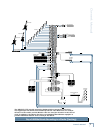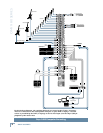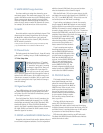
13
Owner’s Manual
Owner’s Manual
17. MUTE GROUP Assign Switches
Use these switches to assign the channel to one or
more mute groups. The master mute groups [54] are lo-
cated in the Master section next to the Talkback section.
When a master mute group switch is pressed, all the
channels assigned to that mute group are muted. This
makes it easy to mute a number of channels all at once,
for example, all the drum mics or all the vocal mics.
18. MUTE
Press this switch to mute the individual channel. This
disconnects the channel’s signal from all the Groups,
the Main Mix, and Aux Send buses (pre* and post-
fader). You can still solo the channel (PFL) when the
MUTE switch is pushed in.
* If the pre-fader Aux Send’s internal jumper is wired for pre-EQ
[14], the MUTE switch will not affect the PRE Aux Send.
19. Channel Fader
The fader controls the channel’s level…from off to unity
gain at the “U” marking, on up to 10 dB of additional gain.
“U” Like Unity Gain
Mackie mixers have a “U” symbol
on almost every level control. This
“U” stands for “unity gain,” meaning
no change in signal level. Once you
have adjusted the input signal to
line-level, you can set every control
at “U” and your signals will travel through the mixer at
optimal levels. What’s more, all the labels on our level
controls are measured in decibels (dB), so you’ll know
what you’re doing level-wise if you choose to change a
control’s settings.
20. Signal Level LEDs
These LEDs indicate the channel’s signal level after
the GAIN and EQ controls, but just prior to the chan-
nel’s
fader. So even if the fader is turned down, you can
see if a signal is present.
If you’ve followed the “Set the Levels”
procedure, the
–20 and 0 LEDs should light frequently, the +10 LED
should light occasionally, and the OL (Overload) LED
should not light at all. If the OL LED is blinking fre-
quently, the signal is probably distorted from overdriving
the input. Either turn down the GAIN control or turn
down the signal at its source.
21. GROUP and MAIN MIX ASSIGN Switches
Alongside each channel fader are fi ve buttons referred
to as channel assignment switches. Used in conjunction
with the channel’s PAN knob, they are used to deter-
mine the destination of the channel’s signal.
With the PAN knob [12] at the center detent, the left
and right sides receive equal signal levels (GROUPS 1-2,
3-4, 5-6, 7-8, and MAIN MIX L-R). To feed only one side
or the other, turn the PAN knob accordingly.
If you’re doing a mixdown to a 2-track, for example,
simply engage the MAIN MIX switch on each channel
that you want to hear, and they’ll be sent to the MAIN
MIX bus. If you want to create a subgroup of certain
channels, engage either the 1-2, 3-4, 5-6, or 7-8 switches
instead of the MAIN MIX, and they’ll be sent to the ap-
propriate Group faders. From there, the groups can be
sent back to the MAIN MIX (using
the MAIN MIX assign switches
[41]
above the Group faders), allowing
you to use the Group faders as a
master control for those channels.
If you’re creating new tracks or
bouncing existing ones, you’ll also
use the GROUP ASSIGN switches,
but not the MAIN MIX switch. Here,
you don’t want the subgroups sent
back into the MAIN MIX bus, but
sent out, via the GROUP SEND jacks
[74], to your multitrack inputs.
However, if you’re printing tracks
via the DIRECT OUTS [70], the
channel assignment switches don’t
matter because the DIRECT OUTS
come before the ASSIGN switches.
22. PFL SOLO Switch
This handy switch allows you to
hear signals through your head-
phones or monitor outputs without
having to route them to the MAIN or
GROUP mixes. Folks use solo in live
work to preview channels before
they are let into the mix, or just to
check out what a particular channel
is up to anytime during a session.
You can solo as many channels at a
time as you like.
The Onyx 80 Series has two solo
modes. PFL (Pre-Fader Listen) is
the default solo mode, and the mode used for soloing
individual channels and the stereo Aux Inputs. AFL (Af-
ter-Fader Listen) is activated whenever an AFL switch
is pressed on an Aux Send, Matrix, or Group.
PFL solo mode always overides any AFL solo mode.
The Rude Solo LEDS below the SOLO meters indicate
which solo mode is active.
GROUP
ASSIGN
5-6
1-2
3-4
7-8
MAIN
MIX
10
dB
30
20
10
OO
40
5
5
U
60
50
OL
+10
0
-20
1
MUTE GROUP
PAN
RL
PFL
MUTE
1
3
2
4


















